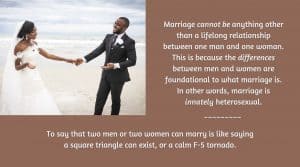In 2017, I wrote a series of articles titled “Myths that Led to the Recognition of Same-Sex Marriage in the United States.” A printable summary of the series is available here. One of the myths we explored is the idea that “Homosexuality is on par with heterosexuality.” Among other things, we did a deep dive to examine realities that make marriage an exclusively heterosexual union. We said that in spite of the overwhelming success of activists’ public relations campaign to advance the idea of same-sex “marriage,” such a concept cannot be a reality:
Stark differences between a heterosexual relationship and a homosexual one remain, and these are realities that cannot be altered. Let’s take a hard, long look at some of the clear reasons marriage must be a heterosexual union.

First, the bodies of a husband and wife fit together. This fitting is clear to us “in the outlines of the genitalia of a male and a female. This is a fitting that obviously is not present with two men or two women. Moreover, sexual intercourse involves precisely one man and one woman. The human bodies of the man and the woman therefore point to monogamy and sexual exclusivity—and those of same sex couples point to abstinence from sexual activity altogether.”
Second, only a heterosexual union can produce children. But wait! someone will say. Some heterosexual couples are childless. First, exceptions do not negate the rule, and second, childless heterosexual couples are not the same aschildless same-sex couples. If a heterosexual couple cannot produce a child, there is a reason other than the fact that their relationship involves a member of each of the two sexes. We know without doubt why two men never will become parents on their own, and why two women will forever remain childless between themselves: Same-sex couples have an innate inability to produce children.
Third, the bodies of a husband and wife work together during sexual intercourse to enhance the probability that the wife’s egg will be fertilized by her husband’s sperm.

Fourth, when a baby arrives, the tiny boy or girl “is totally helpless. She needs nourishment on a regular basis. He needs to have his diapers changed—repeatedly. We are truly deaf and blind in the most extreme sense if we fail to see that nature’s way of bringing a new human life into the world also makes a clear and bold statement about who should have the primary responsibility to care for newborns when they arrive.” The husband and father, who is physically stronger, is better equipped to protect and provide for his wife and the children that result from their union. The wife and mother is better equipped to nurture and care for her children. This does not mean a woman never can have a career outside the home, but let’s listen to what nature says in and through a woman’s body about meeting infants’ physical needs. She and she alone can produce milk that nourishes her children. While it’s true that some women can’t produce enough milk and that some prefer to bottle-feed rather than breastfeed (the couple’s choice), this does not negate at all the natural ability that women have to feed their newborns. Alarmingly, recently a biological man made national headlines because hormone therapy had made it possible for him to breastfeed—but at significant risk to his baby. Mark it down! It is undeniable that he was not “born that way”!

Fifth, because of the innate differences (also go here and here) between men and women, heterosexual couples experience a relational mystery that is non-existent among same-sex couples. While homosexuals often do experience a sense of mystery with regard to their own sex or gender, the mystery of which I write here is focused on the opposite sex; and consequently, in a heterosexual relationship, on the other person. When a couple approaches this relational dynamic properly, it serves to enhance their relationship and cement their bond. [Consider: the mystery inherent in a man-woman relationship is natural, because neither the man nor the woman has an experiential understanding of what being a member of the opposite sex would be like. The mystery in a homosexual relationship arises because, for a variety of reasons, neither party in the relationship has arrived at a place of confidence regarding his or her own identity as a male or a female. Thus, he or or she is looking to the same-sex partner for answers to the mystery he or she is experiencing. With all the gender confusion out there, is it any wonder that homosexual relationships have increased in number?]
Sixth, male-female differences can be seen in parenting styles. Children need both the strong influence of a father and the encouraging, nurturing touch of a mother.
Seventh, natural reproduction “isn’t just about caring for babies and children so they will grow up to become responsible individuals; it’s also about maintaining a healthy society for years to come. The future of the human race depends on reproducing it so those dying out can be replaced. This can occur only with heterosexual couples. As Charles Colson put it, ‘The survival of the human race depends upon marriage as the institution by which we procreate and perpetuate civilization.’”1
Eighth, majority opinion in the Obergefell has a strong emphasis on autonomy that stands in opposition to the selflessness and sacrifice necessary in a real marriage. Here are two examples. The ruling states, “Four principles and traditions demonstrate that the reasons marriage is fundamental under the Constitution apply with equal force to same-sex couples. The first premise of this Court’s relevant precedents is that the right to personal choice regarding marriage is inherent in the concept of individual autonomy.” The decision also says, “The fundamental liberties protected by the Fourteenth Amendment’s Due Process Clause extend to certain personal choices central to individual dignity and autonomy, including intimate choices defining personal identity and beliefs.” Again, the ruling’s emphasis on autonomy (and here we’ve cited just two examples) stands in stark contrast to the interdependency that is inherent, and inherently necessary, in a marriage, where the goal is for the two to become one. I realize that with regard to same-sex couples, we are speaking of “committed relationships.” So why is it that the ruling has to underscore individual autonomy so much? If it didn’t, it couldn’t justify making same-sex relationships eligible for marriage. Yet in doing so, the ruling contradicts one of the core principles of marriage!
Ninth, homosexuality is associated with increased risks to one’s psychological health (also go here and here). Although researchers may speculate that the cause of these risks is discrimination against gays and lesbians, this trend is evident even in the most gay-friendly places.
Tenth and finally, homosexuality is associated with increased risks to one’s physical health. Heterosexual intercourse, obviously, is not the same as homosexual intercourse. Glenn Stanton of Focus on the Family puts it politely—but you readily can understand what he means.
One of the key reasons for the significant risk of disease and physical trauma associated with homosexuality is due to the design of human anatomy and how this anatomy is misused during homosexual sex. The bodies of two individuals who are of the same sex are not designed to be united sexually. Homosexual activity misuses parts of the body that produce no natural secretions to protect against infection and that are designed to carry out other bodily functions.
By contrast, body parts that unite in exclusive, marital, heterosexual sex were created for that activity by God. God also designed the human body so that it protects itself against abrasion and infection, and thus disease, naturally. Sexual fidelity between a husband and wife also keeps infection and disease at bay. In other words, a woman and a man were created by God for sexual union in marriage; the bodies of a husband and wife fit together.2
We therefore are back to item #1.
Another writer, Dr. Paul Cameron, doesn’t describe the situation as politely as does Mr. Stanton. Yet, we need their descriptions, because they help us more readily understand why homosexuality puts health and even life expectancies at risk.
While here we have not up to this point emphasized the biblical and theological reasons homosexuality is harmful and wrong, this perspective also is important. Go here to read an excellent article that cites biblical teachings on this matter.
Copyright © 2022 by B. Nathaniel Sullivan. All rights reserved.
top image credit: Photo by Alvin Mahmudov on Unsplash
couple on beach: Photo by Osarugue Igbinoba on Unsplash
Notes:
1Charles Colson with Anne Morse, My Final Word, (Grand Rapids: Zondervan, 2015), 142.
2Glenn Stanton, “Homosexuality: A Christian Perspective” in A Single Pursuit, Winter, 1998-99, (Nashville: LifeWay Christian Resources of the Southern Baptist Convention, 1998), 85.

